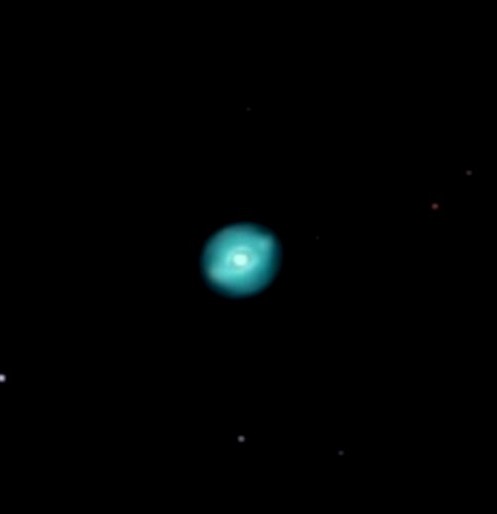
|
|
| C6 (Caldwell #6), The Cat's Eye Nebula, NGC 6543; and C15, NGC 6826 |
|
These are tiny objects, only 12x18 arc seconds for C6 on the left and 25 arc sec. for C15 on the right. I've enlarged C6 to 300% and C15 200% for show here. With binoculars they look like any other star in the heavens, although no star would be quite as blue/green as these. In a telescope with 200-400x magnification it is revealed they're not just stars. Early astronomers who didn't have good telescopes or understanding of these objects (and there are a number of them) thought they looked a lot like planets, especially in these two examples, a lot like Uranus and Neptune.. They were about the size of planets, but appeared fuzzier, or nebulous. So they called them Planetary Nebula, a category name for these type objects that has stuck to this day. The star at the center of both these Pl. Neb. is a white hot uncovered core of a previously larger star. They've both gone through their red giant phase where they puffed off most of their outer layers. The nebulous region around them is part of the star's expelled outer layers, and are the blue-green fluorescing glow of double and triple ionized oxygen (OII & OIII). At first, astronomers didn't know it was oxygen that was glowing, because there was no way on earth to fire up oxygen to the 100,000 degrees Kelvin needed to double and triple ionize oxygen. By the late 1920's and 30's though, the mathematics of nuclear chemistry started to be understood well enough to figure out that OII and OIII should glow in the specific wavelengths seen here. Although they couldn't create such conditions to test their math and nuclear theories, physicists and astronomers began to realize that in the heavens situations existed where such elements at such temperatures could be observed. That's when the melding of astronomy and physics began, and became the discipline we know today as Astrophysics. Both of these objects can be seen high in the sky in mid summer. The Cat's Eye is just to the west of the Milky Way between the last 2 stars of Draco the Snake, just before that constellation's line of stars turn toward the snakes head. C15 is in the west part of the swath of the Milky Way, a bit northwest of the bright west star of Cygnus the Swan. The Cat's Eye is about 3300 light years away. Its namesake nebula has formed and expanded to its present size over the last 1000 years. C15 is closer to us at about 2000 light years away. It's a much less studied object than C6. It's nebula is also about 1000 years old. |
|
10" Schmidt Cassegrain
Telescope at f7.6, with Canon 5D Mark II and IDAS LP-2 filter. |